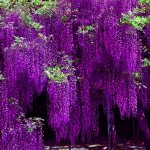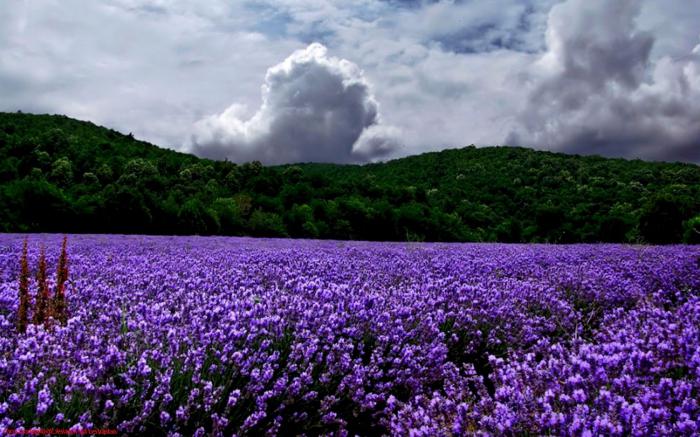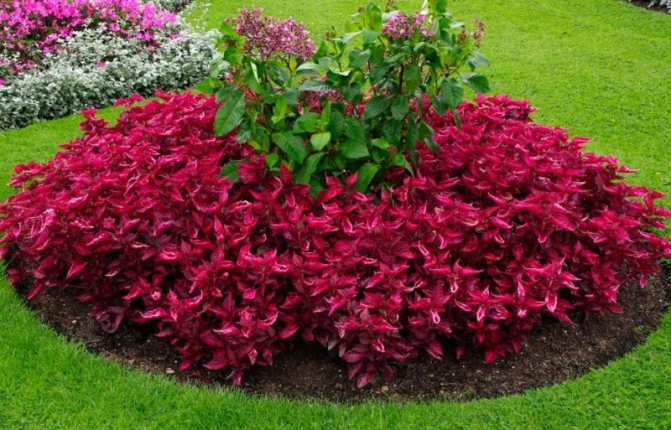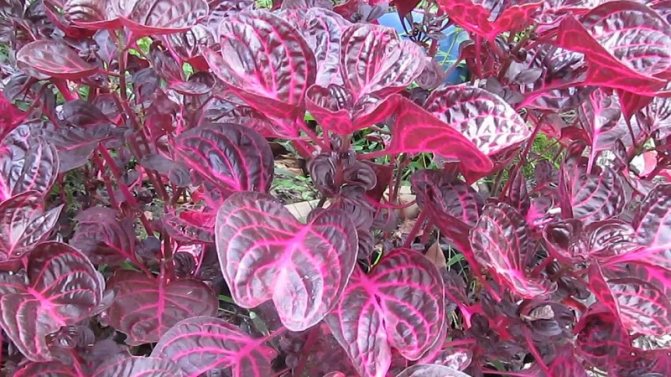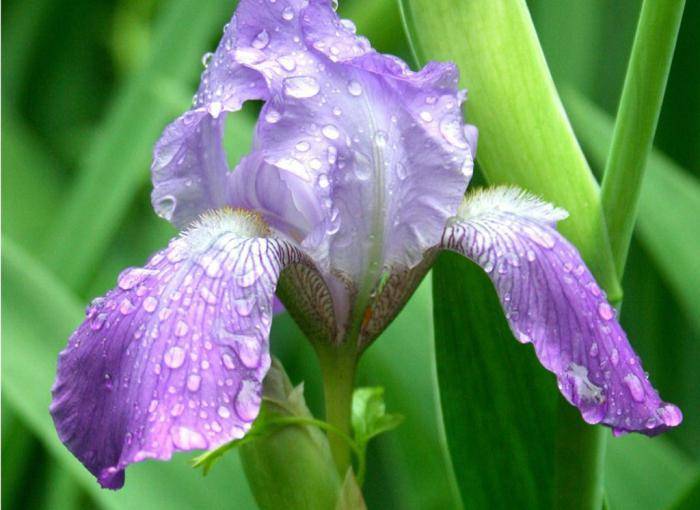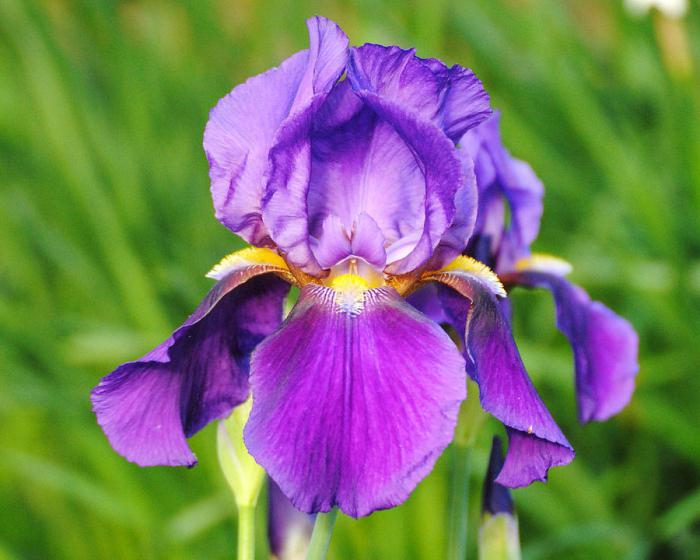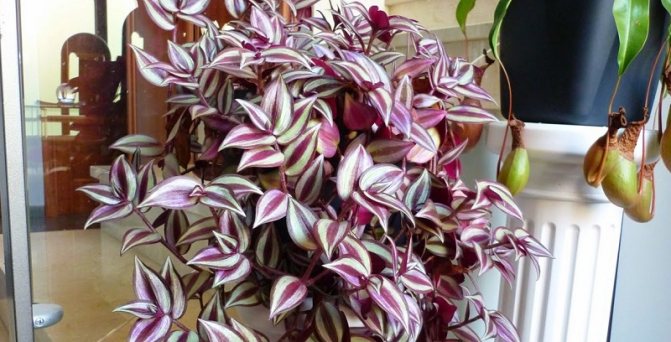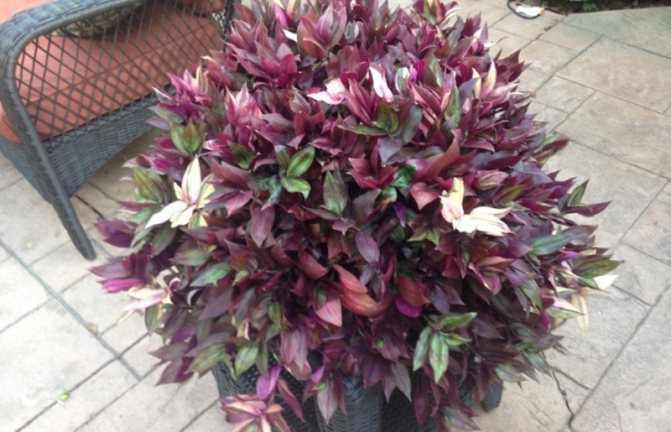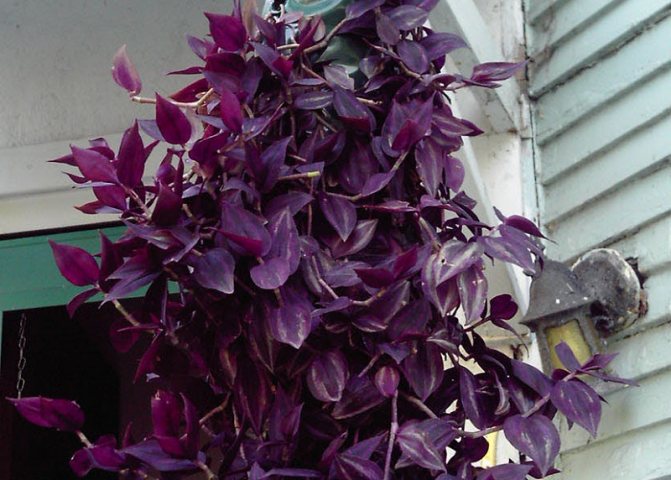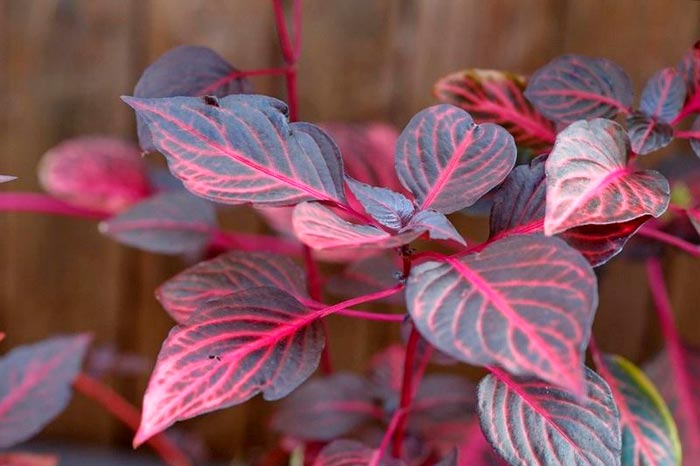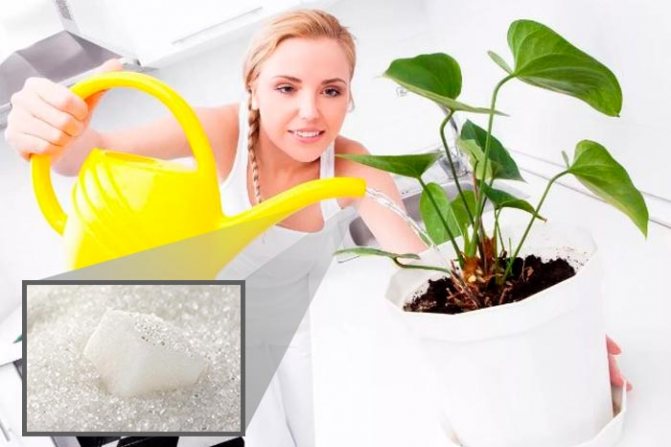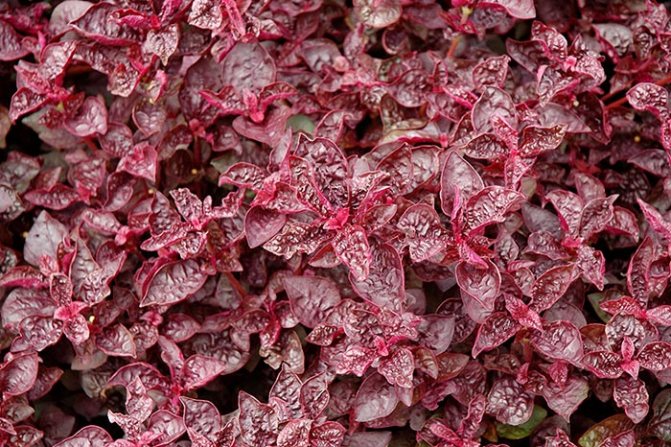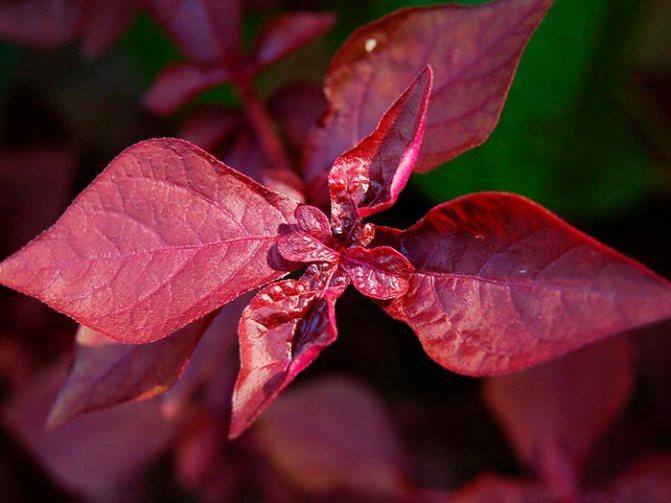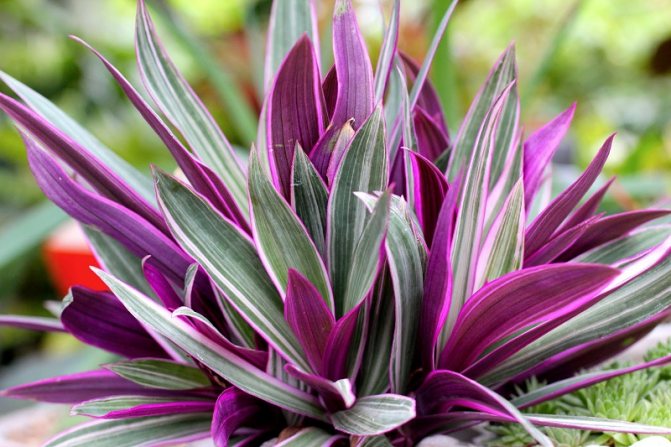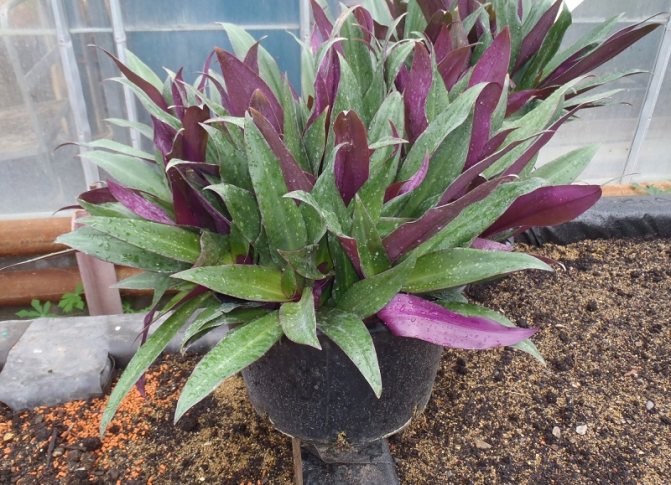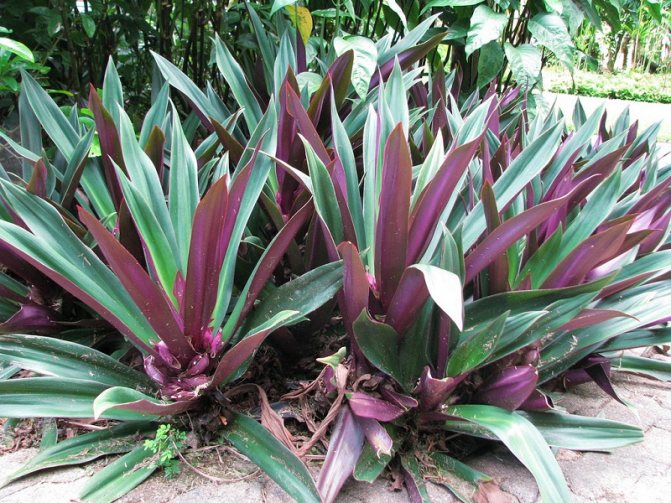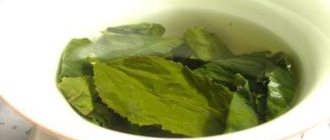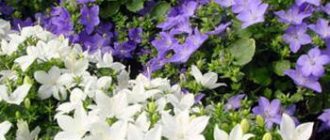Magnificent asters
Among the many varieties of these flowers, there are both annuals and perennials. Asters have flowers in lilac, purple, blue, red, orange and white. Below are those varieties that are dominated by purple or lilac shades:
- Alpine aster is a perennial, the most popular purple flower. The name in Latin is aster alpinus. Its flowers are light purple or lilac, and may be white;
- Aster chamomile (aster amellus) - the Italian aster has a light purple flower;
- Prof. an. Kippenberg - purple
- Treasure - with deep purple flowers;
- Novi-belgii - lilac in the New Belgian;
- Aster sedifolius - inflorescences have a mixed lilac-blue hue.
Why are they called that?
Often, the name of wildflowers speaks of the noticeable features of plants. Mother-and-stepmother is named that way because of the leaves - warm, terry on the one hand, smooth and cold on the other. The flowers of the crane resemble the beak of this slender bird, and the flowers of the bell are similar to the bell. Oregano has a unique aroma, especially when dried. Tea is obtained from it very fragrant. Elecampane acquired its nickname due to the fact that it helps with weakness and fatigue: it gives a person "nine powers". It also happens that the name of wildflowers is associated with myths and legends. They say that the cornflower is named after Saint Basil the Great, who had a special sympathy for flowers, and is a symbol of kindness and spiritual purity. The flowers on the stems of Ivan da Marya got their name from the legend of unhappy love. The girl and the guy, having learned that they are brother and sister to each other, so as not to part, turned into flowers of different shades. The dream-grass flower is so called because at night the petals close tightly, and the plant wilts, as if falling asleep. Another name for this flower is lumbago. According to legend, an angel shot an arrow at the demon, hiding in the thickets of this plant, and shot through the leaves.
Clematis hedge
Plants with purple curly flowers are clematis. They can be dark blue, lilac or light blue. The stems climbing the hedges or the wall of the house, which are strewn with hundreds of large flowers, create an unusual atmosphere in the garden. Arbors, pergolas or arches are decorated with clematis. These flowers can be called the queen of the vines. They belong to the buttercup family, distributed throughout the world. Clematis can adapt to any climatic conditions, therefore they are resistant to both severe frosts and heat.
The length of the stems of clematis can reach 5 m. Despite the small thickness of the stem, it is very strong. Leaves can be of different shapes, shades and density.Clematis flowers can be simple, semi-double and double.
Planting and leaving
Clematis should be planted in a sunny location, protected from strong winds. Acidic soils and stagnant water are fatal for these plants. Clematis grows rapidly, so they require a lot of nutrients. Since this flower is a perennial, it grows in one place for up to 10 years.
Chlorophytum care, transplantation and reproduction of a flower
Rotted humus, mineral fertilizer, slaked lime and wood ash must be added to the planting pit. Clematis can be planted in the spring, at the end of April or in the fall, in September-October. It is better to use rooted two-year-old cuttings as planting material. After planting, the roots must be spread over the surface, covered with soil and watered. The root collar should be deepened 10 cm into the ground to protect the roots from frost and overheating.
It is necessary to prepare support for the stems and shoots. A lightweight, sleek and stable design will do. Intensive growth of shoots will begin in the spring (12 cm per day), so you will need to guide them along the support.
In care, this plant with purple flowers is unpretentious, he needs: weeding, loosening and watering. In the spring, it is necessary to add urea, and in the summer, during flowering, feed it with a complete mineral fertilizer with trace elements.
To prepare clematis for wintering, the ground near the flower must be weeded, loosened and cut off the shoots, leaving 2 knots. After that, it is necessary to spud earth 12 cm so that the plant does not freeze. In the spring, clematis uncoil. For reproduction of clematis, bush division, cuttings and seeds are used.
Purple leaves in potted crops
Such plants are grown for interior decoration, oxygenation of the air and for aesthetic pleasure. Flowers with purple leaves represent the following types:
Ginura
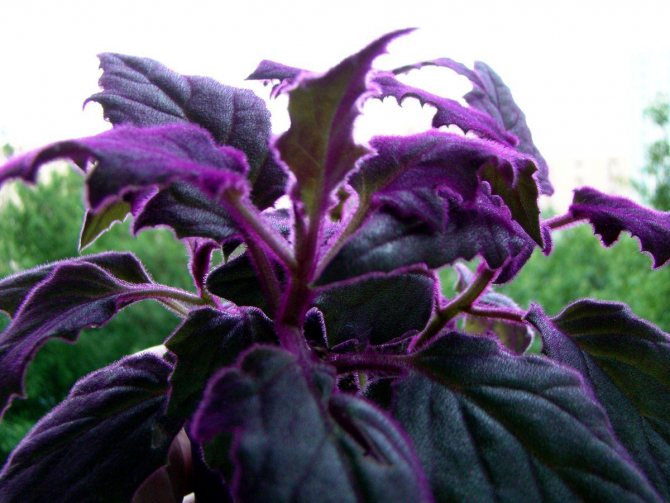
She has lilac, deep purple and burgundy carved leaves, there are purple hairs on the wavy plates. Loves bright lighting, unpretentious care. It should be planted in soil with neutral acidity, occasionally loosened. Soil composition: leafy and sod land, coarse river sand. The temperature in summer is 20-24 ° C, in winter - up to 13 °. If you keep it in a warm room in winter, then you need to extend the daylight time with additional lighting with lamps. With active growth, feed 2 times a month. To create an ornamental bush, Ginuru is regularly pinched to branch better. Rejuvenation: cutting of the apical cuttings and their rooting is carried out every 2 years.
Zebrina
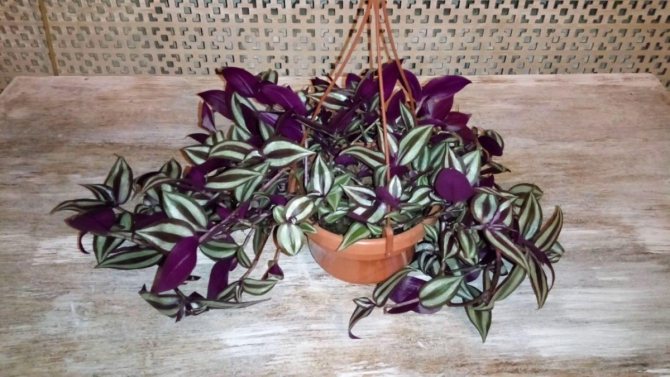

An unpretentious houseplant with striped leaf blades: silvery green and purple. Should be exposed to well-lit windowsills to maintain rich colors, leaves will turn pale green in the shade. But the plant must be protected from direct sunlight. They are fed every 2-3 weeks in April-September, watered moderately, planted in soil mixture, as for Ginura. After a year, the bushes are rejuvenated by cutting off the tops and rooted in a pot or placed in water to obtain roots. Do not overfill the plant with water, as the leaves may dry out.
Fragrant and healing lavender
This shrub with oblong-linear leaves and flowers, collected in inflorescences at the top of the shoot, belongs to the family of lamines. The birthplace of lavender is considered to be Southern Europe, where it grows on the mountain slopes. In these parts, they began to use it as a medicinal plant. Later, an essential oil was extracted from lavender on an industrial scale. Lavender was brought to Russia in the 18th century in Astrakhan.
All parts of the plant are rich in essential oils, but especially in flowers. Lavender has been used as a medicinal raw material since the time of Hippocrates. With the help of infusions they treat:
- exhaustion of the nervous system;
- fainting;
- dizziness;
- poor eyesight;
- damage to the vocal cords;
- neurasthenia;
- migraine;
- insomnia.
Lavender needs to be constantly looked after: watering, weeding, loosening the soil, feeding it with fertilizer and preparing it for winter. Lavender does not tolerate cold, so in areas where there are cold days, the flower is planted in flowerpots and taken to a warm place during bad weather.
Hyssop medicinal
Hyssop is perhaps one of the most aromatic herbs in the world. Despite its small size (it grows up to 50 cm in height), the plant exudes a rather strong aroma. The shoots of hyssop are so densely covered with leaves collected in whorls that they are practically invisible. Dark blue and dark pink small flowers appear in the axils of the leaves.
In order for the hyssop to fully show its decorative qualities, it should be planted in an open, sunny area with drained soil. High-lying groundwater is just as destructive for this plant as it is for oregano.
Fragrant lilac
Lilac is one of the favorite ornamental plants., which are bred for beautification and city streets and garden plots. It begins to bloom in mid-May. In addition to the amazing beauty of the bushes, lilac flowers spread a pleasant aroma around them.
Features of the reproduction of the croton flower at home
Common lilac is a representative of the olive family. It is a large shrub that resembles a small tree. Its leaves remain green until late autumn, do not turn yellow. Lilac flowers, depending on the variety, can be purple-violet, violet-blue, lilac-pink or white. There is also a combined color: dark purple petals with a white border. In Eurasia, up to 30 species of lilac grow, and in Russia there are 3 species.
To grow lilacs in a garden plot, it is enough to make a minimum of effort. The soil for planting must be fertile and well-drained. Lilacs are planted from mid-summer to September. A distance of several meters should be left between the bushes so that they do not shade each other. The shrub must be watered and mulched. In the first few years, you do not need to fertilize lilacs, and then you will need to add urea or ammonium nitrate.
Beneficial features
Flowers, leaves, buds and bark of branches have healing effects. Infusion of lilac flowers is used as a diaphoretic, expectorant and diuretic. It is used for the following diseases:
- bronchitis;
- pneumonia;
- inflammation of the bladder;
- bronchial asthma.
Fresh lilac leaves are applied to heal festering wounds and ulcers. For thrombophlebitis, poultices are made from fresh leaves or their strong decoction.
Features of growing Kislitsa
Kislitsa is also called the clover of happiness, hare cabbage or Madame Butterfly. According to popular beliefs, there is a belief that a plant brings happiness and good luck to the house, but on the last day of the year, the plant must change its owner, this is the main condition. The leaf of the plant has a structure of three parts, so many believe that this is the personification of the Holy Trinity. This plant is depicted on the coat of arms of Ireland. The plant is herbaceous, and perennial, there are about 800 varieties of it. Such a plant can be in the form of grass, shrub or semi-shrub. Violet Kislitsa is the most beautiful bush that blooms throughout the spring and summer, until autumn. A month after planting, the plant begins to bloom with small invisible flowers that have a purple tint. The plant is of tropical origin and can be grown as an indoor flower.
Kislitsa has its own peculiarity, in inclement weather or at night, its leaves merge and fall, the plant becomes like a flock of butterflies, which is why it received the name "Butterfly Flower". When the plant has enough light, the leaves take on their normal appearance.
Irises and crocuses
There is a legend that the very first iris blossomed millions of years ago in the subtropical forests of Southeast Asia. In the 14-15 centuries BC. e. purple flowers were bred in ancient Egypt. There, iris was considered a symbol of eloquence. Later, this flower appeared in Spain, France, England and Russia and other countries.
Highlander plant: planting and caring for a shrub
In Russia, iris had the most unexpected names. They were also called cockerels and magpies and pigtails. But the most common is iris, meaning "dear and beloved."
Iris bloom from May to July. The best time to plant is right after flowering ends. Irises grow and bloom in one place for 5 years.
A beautiful little flower with a small yellow center is called a crocus. With the first rays of the spring sun, these flowers are among the first to bloom. They delight gardeners on the site, and lovers of home flowers can grow them on the windowsill.
Crocus belongs to the iris family. These are low, perennial bulbous plants. These bright yellow, blue, white, purple flowers grow throughout Europe and Asia.
Planting crocuses on the site will not cause much trouble, because there are no weeds yet, so you don't have to weed, and the soil is moist enough. But the soil should be selected in such a way that moisture does not stagnate in it; soil with high acidity is suitable.
Crocuses blooming in autumn are planted in late July, and spring crocuses in autumn. It should be noted that crocuses grow rapidly, so the distance from one bulb to another should be significant - about 10 cm. After flowering, the bulbs must be dug up and stored in a dry place until the beginning of the next season.
Annuals with lemon flowers
Cold yellow-green and lemon tones (in Eastern philosophy they were "responsible" for health) will visually refresh your flower garden, becoming the brightest, first of all eye-catching spot. They're not as active as the warm shades of yellow, so it's harder to overdo them.
Marigold
We are more accustomed to seeing bright balls of these native American flowers in orange-red color, but we suggest you "get confused" and find more original lemon varieties.
Marigolds are very easy to breed and have numerous medicinal properties. Their seeds can be sown directly into open ground in late spring when the ground is warm enough. Marigolds need soil that is loose, nutritious, well moistened in the first half of summer, loamy and neutral. They bloom most magnificently in the bright sun, but they will not disappear in the shade. And the phytoncides secreted by these plants will protect not only them, but also their neighbors in the flower garden from fungal diseases.
Calendula
The so-called "marigolds" are one of the most popular plants of the Astrov family. They bloom profusely all summer, are extremely unpretentious, cold-resistant, are successfully used in folk medicine, cosmetology and even cooking.
Calendula will grow in almost any area and soil, although, of course, it will prefer a sunny and fertile place. It can be sown in the spring directly into the ground, if the plantings are thickened - both young seedlings and adult plants tolerate transplantation well. Of the pests for calendula, only aphids are dangerous, all other parasites are “brave” by itself due to its pronounced bactericidal properties.
Sunflower
If you think that sunflowers are just huge yellow-orange "suns" on a high stem that give us seeds, you are wrong. There are a lot of types of helianthus, some of them are used as ornamental garden plants, and the usual oilseed sunflower has forms with flowers of various colors.
Ornamental sunflowers are unusually diverse - there are very tall and dwarf plants, single-stemmed and branched, with double and simple flowers of orange, golden, lemon and pure yellow shades. It is a very docile crop that propagates by seed and requires minimal maintenance.
Reproduction
Nature itself has come up with a very convenient way of reproduction for rheo - by lateral processes. In the tropics, this gives the plant the ability to easily and quickly expand its habitat.
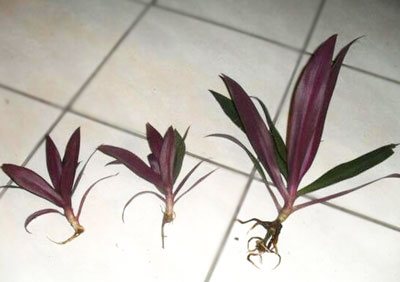

At the same time, the varietal characteristics of the maternal rheo remain completely.
This rule is not violated in the process of home breeding.
However, flower growers love to experiment, which means that you can try to increase the "plantation" rheo by sowing seeds.
Seeds
If the plant has received enough heat and moisture from the sun, the seeds ripen well.
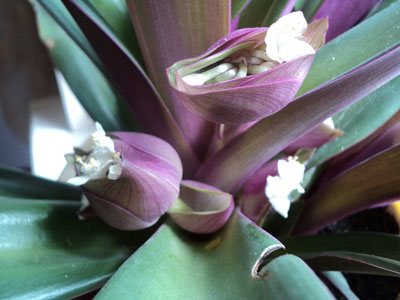

Before planting, they are soaked in water with the addition of a drug that stimulates growth.
Planting begins in a day.
It is not necessary to press the seeds into the soil; it is enough to sprinkle it on top with a 2 mm layer of soil.
With the help of a plastic bag, they construct a kind of greenhouse and patiently wait (from time to time moistening the soil) from two to six weeks for the emergence of shoots.
All this time, it is desirable to maintain the temperature in the room at 20-22 degrees. The "greenhouse" is removed after the formation of two true leaves.
There are several varieties or varieties:
- Striped (from Lat. Rhoeo vittata) - a distinctive feature is the presence of longitudinal light stripes on the front side of the leaves. Narrow stripes are quite sparse and are located closer to the edges of the leaf, and towards the center they thicken a lot;
- Pink (from Lat. Rhoeo stripe in pink) - characteristic stripes acquire a pinkish tint - it looks very unusual, the reverse side of the leaf is no longer purple, but gives off pink;
- Multi-colored (from Lat. Rhoeo discolor) - this variety is characterized by both light and dark stripes on the front side of the leaf, and the contrast of the leaves due to these transitions gives a special decorative effect to the flower as a whole.
Diseases
If the houseplant doesn't look very healthy, try to figure out the reasons and, if possible, eliminate them:
- small leaves - lack of food and light;
- yellow spots - sunburn;
- growth retardation and loss of root leaves - excess moisture;
- pale colors, thin long stems - a lack of light;
- dried, turned brown tips of the leaves - too dry in the room;
- shriveled leaves - cold or oversaturated water for irrigation with bleach;
- loss of springiness - low room temperatures.


The first aid to the victim must be provided, oddly enough, also with water - to arrange a warm shower for the patient.
In this way, it will be possible to wash off the pests. If the leaves are severely affected, they will have to be removed.
TIP: transplanting rheo into another pot with new soil is effective, while the roots affected by the disease should be cut off.

